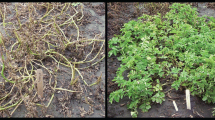Abstract
Transformation of potato is a genotype dependent process as was shown by experiments conducted with 16 varieties. Not all genotypes could be transformed with a single procedure hence two different procedures were attempted for all 16 varieties in a pilot experiment. Large differences in regeneration capacity of putative transformants were observed with the two protocols. Regeneration capacity and transformation efficiency were not correlated. All varieties were transformed with the same construct, composed of a kanamycin resistance gene and an antisense gene coding for granule-bound starch synthase. This led to different percentages of plants with the desired maximum effect (i.e. amylose-free starch) ranging from less than 1 percent to 23.3 percent. It was shown that variety-dependent phenotypic variation occurred ranging from 1 to 21%. Field experiments, conducted over a number of years, using plants with different degrees of antisense effect (from no detectable effect to maximum effect) showed that most transformants would have a decreased yield and starch content as determined by specific gravity measurements. However, these negative effects can be overcome by selecting the proper transgenic plants. Molecular characterisation of transformants using PCR, showed that 90% of the analysed transgenic plants, belonging to all effect classes, contained vector DNA sequences since they contained either the NPTIII gene or the trfA gene. The other 10% of the transgenic plants had no insertion of vector DNA.
Similar content being viewed by others
References
Anonymus, 1997. Publicatieblad Raad voor het Kwekersrecht, 16.09.97.
Belknap, W.R., D. Corsini, J.J. Pavek, G.W. Snyder & D.R. Rockhold, 1994. Field performance of transgenic potatoes. In: W.R. Belknap, M.E. Vayda & W.D. Park (Eds.), The Molecular and Cellular Biology of the Potato, pp. 233–243, 2nd edition CAB International Wallingford, Oxford, UK.
Dale, P.J. & K.K. Hampson, 1995. An assessment of morphogenic and transformation efficiency in a range of varieties of potato (Solanum tuberosum L.). Euphytica 85: 101–108.
Edwards, G.A., A. Hepher, S.P. Clerk & D. Boulter, 1991. Pea lectin is correctly processed, stable and active in leaves of transgenic potato plants. Plant Mol Biol 17: 89–100.
El Kharbotly, A., E. Jacobsen, W.J. Stiekema & A. Pereira, 1995. Genetic localisation of transformation competence in diploid potato. Theor Appl Genet 91: 553–557.
Heeres P., A.C. van Swaaij, P.M. Bruinenberg, A.G.J. Kuipers, R.G.F. Visser & E. Jacobsen, 1995. Biosafety aspects on field testing with transgenic amylose free potatoes. Proc 3rd Int Symp on the Biosafety Results of Field Tests Genetically Modified Plants andMicroorganisms. Univ. California, USA, pp. 271–282.
Heeres, P., E. Jacobsen & R.G.F. Visser, 1997. Behaviour of genetically modified amylose free potato clones as progenitors in a breeding program. Euphytica 98: 169–175.
Hovenkamp-Hermelink, J.H.M., J.N. de Vries, P. Adamse, E. Jacobsen, B. Witholt & W.J. Feenstra, 1988. Rapid estimation of the amylose/amylopectin ratio in small amounts of tuber and leaf tissue of the potato. Potato Res 31: 241–244.
Jongedijk, E., A.A.J.M. de Schutter, T. Stolte, P.J.M. van den Elzen & B.J.M. Cornelissen, 1992. Increased resistance to potato virus X and preservation of cultivar properties in transgenic potatoes under field conditions. Bio/Technology 10: 422–429.
Kuipers, A.G.J., W.J.J. Soppe, E. Jacobsen & R.G.F. Visser, 1994. Field evaluation of transgenic potato plants expressing an antisense granule-bound starch synthase gene: increase of the antisense effect during tuber growth. Plant Mol Biol 26: 1759–1773.
Kuipers, A.G.J., W.J.J. Soppe, E. Jacobsen & R.G.F. Visser, 1995. Factors affecting the inhibition by antisense RNA of granule-bound starch synthase gene expression in potato. Mol Gen Genet 225: 289–296.
Murashige, T. & F. Skoog, 1962. A revised medium for rapid growth and bioassays with tobacco tissue cultures. Physiol Plant 15: 473–497.
Visser, R.G.F., 1991. Transformation of potato. In: K. Lindsey (Ed.), Plant Tissue Culture Manual, B5: pp. 1–9. Kluwer Academic Publishers.
Visser, R.G.F., I. Somhorst, G.J. Kuipers, N.J. Ruys, W.J. Feenstra & E. Jacobsen, 1991. Inhibition of the expression of the gene for granule-bound starch synthase in potato by antisense constructs. Mol Gen Genet 225: 289–296.
Wolters, A.M.A., L.M. Trindade, E. Jacobsen & R.G.F. Visser, 1998. Fluorescence in situ hybridization on extended DNA fibres as a tool to analyse complex T-DNA loci in potato. The Plant J 13: 837–847.
Author information
Authors and Affiliations
Rights and permissions
About this article
Cite this article
Heeres, P., Schippers-Rozenboom, M., Jacobsen, E. et al. Transformation of a large number of potato varieties: genotype-dependent variation in efficiency and somaclonal variability. Euphytica 124, 13–22 (2002). https://doi.org/10.1023/A:1015689112703
Issue Date:
DOI: https://doi.org/10.1023/A:1015689112703




